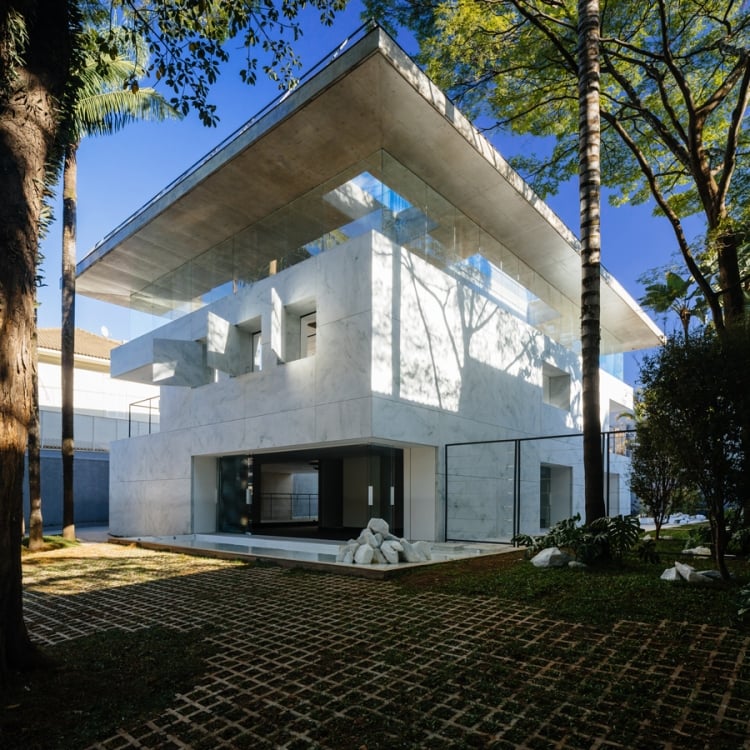
March 30, 2015
In a City Defined by Walls, This São Paulo Gallery Is Astonishingly Transparent
Triptyque defies the conventions of Brazilian Modernism and São Paulo’s urbanism in the new Groenlândia gallery.

A 3,200-square-foot concrete deck appears to float above the marble block of Groenlândia, a gallery in São Paulo’s Jardim América neighborhood. The architect Carolina Bueno waxes poetic about the material choices: “Concrete for us is stone with water, the marble is true stone.”
All photographs courtesy Pedro Kok
Brazil’s early, zealous adoption of Corbusian Modernism is a legacy that weighs heavily on its young architects, says Carolina Bueno, a partner of the Brazilian-French firm Triptyque. The formalist brio associated with Oscar Niemeyer remains the poster image of modern Brazil. But, as Bueno argues, apart from a few paroxysms—the quasi-Brutalism of João Batista Vilanova Artigas or Lina Bo Bardi’s earthy works—”Brazilian architecture has been sleeping ever since. Not exactly dead, but sleeping.”
If that’s the case, then Triptyque’s recently completed Groenlândia gallery could be read as a kind of mausoleum. Faced entirely in white marble, the building is hunkered down in São Paulo’s tony Jardim América neighborhood. Its corner edge is carved out in an act of transparency—the piano nobile is partly exposed to the street—that’s shocking for a city defined by security encampments for its wealthiest inhabitants. “Unfortunately, in São Paulo there is this enclosure type of architecture, walls behind walls,” Bueno says. “We don’t believe in that—we fought a lot not to have walls.”
Set behind a thin screen of jacaranda and palm trees, the gallery’s cubic form is punctured by several openings placed at different heights that lend the project an airy nonchalance. Perhaps more cynically, the pivoting marble panels can easily be shuttered to quickly turn the building into a bunker. A shallow pool forms a perceptual barrier between the entrance and the street, presenting a gossamer apposition to the somber fact of the stone cladding. This superstructure obscures the expressively cast concrete core, which absorbs and literally embodies all the architecture’s phenomenological put-ons—“solid” and “liquid” being bridged by concrete’s slippery substance, after all.

Left: The core of the gallery is cast in concrete—or “liquid stone,” as Bueno calls it. The building’s most distinctive features include the movable marble apertures. Right: At the corners of the stone block are water gardens, with rock formations and papyrus plants, designed in collaboration with Bia Abreu. “All the materials—the hard, the soft, the liquid —become water as they dissolve into the water bed,” Bueno says.
“We see our architecture as being composed of sensorial moments in space,” Bueno says. “In all our other projects, but with the Groenlândia specifically, there is a kind of naturalism at work.” Because this “naturalism” is achieved by architectural means—namely, tectonics and material choices—it isn’t bound by the geographical limitations implied by other seemingly comparable terms, like “tropicalism.” For instance, Triptyque’s nearby Harmonia 57 artists’ studio inventively interprets Brazilian tropicalia not as the aesthetic adjacency of cantilever and untamed verdure, but as a matter of architectural design. Recalling Juan O’Gorman’s binary ateliers for Diego Rivera and Frida Kahlo (complete with catwalks), the house is periodically shrouded in a mist that saturates the seedlings fixed to the porous concrete facades. “Each project has its own soul—always as a living organism, with the power of nature,” Bueno says. This nature is, of course, engineered to a great degree, and the idea was so potent that in 2011, the Financial Times rightly described the building as “the cult ‘green building’ of the moment.”
Meanwhile, the Groenlândia gallery eschews the greenhouse exhibitionism—and the wonky, steampunk apparatus undergirding it—in the name of sobriety. For the architects, the extensive use of marble was “a serious matter of posture” whose surface-level severity downplays the structure’s more hubristic moments, such as the cantilevered concrete roof that hovers miraculously over the clerestory band of glass. And in constraining itself to the Platonic profile, the gallery strikes a stoic, contemplative tone, contrasting with the exuberant gestures of the erstwhile masters. The results, Bueno says, are “beautiful, by which I mean gentle.”






